by W. Cranshaw and R. Hammon* (6/13)
Quick Facts…
- The caterpillar of the codling moth is the common ‘worm’ in a wormy apple or pear.
- Most injury is usually produced by the second generation, which begins in early summer.
- Non-chemical controls that can reduce fruit damage include fruit thinning, prompt removal of infested fruit, bagging of fruit and the use of certain traps.
- Insecticides are useful when applied to coincide with periods when eggs are being laid and before the newly hatched caterpillars borer into fruit.
- Pheromone traps can be useful in timing sprays.
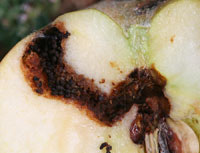
Figure 1. Tunneling of apple fruit caused by larvae of the codling moth. |
Codling moth is the most important insect pest of apple and pears in North America. Damage is done by the larvae, which are cream-colored caterpillars that tunnel fruit and produce ‘wormy’ apples (Figure 1). Control of this insect can be difficult due largely to the feeding habits of the insect, but several measures may be used in home orchards to effectively manage codling moth.
Description of the Insect
The adult codling moth is a small moth, approximately 1/2 inch in length (Figure 2). The general coloration is grayish in appearance with narrow alternating bands of white. The tips of the wings are coppery. Adult codling moths are rarely seen since they are most active during nighttime hours. The larvae, which are usually found in the fruit, are creamy white to slightly pink. The head and thoracic shield are brown or black. The body will turn from creamy white to a slight pink color.
Codling Moth Injuries
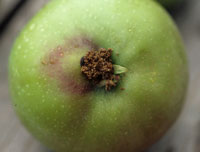
Figure 3. Excrement of a codling moth caterpillar expelled from point of entry near calyx end of an apple fruit. |
Codling moth larvae can enter fruit at any point on the surface of apples but often attack at areas that provide some cover such as the stem end, calyx end, or where two fruit touch (Figure 3). Larval entry into pears, which are harder-skinned, is primarily at the calyx end and attacks of pear occur later in the growing season. Rarely, codling moth larvae have been found in cherries, peaches and large-fruited crab apples. Although control of codling moth in these crops is not necessary, infestations in crab apples can be significant sources of codling moth that may later migrate to nearby apple and pear trees.
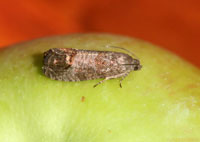
Figure 2. Adult codling moth. |
Although the caterpillars tunnel through the flesh, most feeding is concentrated on the developing seeds of the core (Figure 4). When full-grown they again tunnel out of the fruit, creating larger wounds. Brown excrement is piled around the entry point and where they exit the fruit.
Life History and Habits
Codling moth spends winter as a fullgrown caterpillar within a silken cocoon, pupating in late winter or early spring (Figure 5). Adult codling moths first emerge in spring, typically within days of apple bloom. Earlier emergence may occur if the insects spent wintering next to a building or other warm area. Peak emergence can occur within a week of the first moth emergence, but the last moth of the first generationmay not emerge for six or seven weeks. Mating occurs within a few days of adult emergence followed by egg laying. Egg laying increases as night time temperatures increase above 62°F.

Figure 4. Late stage caterpillar of a codling moth feeding within an apple. |
Eggs are deposited singly on apples and leaves. Each egg is about the size of a pin head and is translucent, gradually darkening as the egg nears hatching (Figure 6). Eggs hatch in six to 14 days, depending on temperature. Within 24 hours of hatching the larvae burrow into the fruit. The first instar larvae have a pink body with a black head and are approximately 1/10 inch in length. The number of eggs laid per female ranges from 30 to 70.
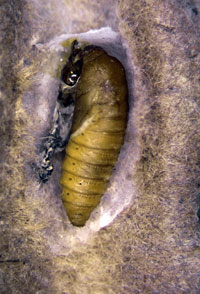
Figure 5. Pupa of a codling moth. |
The larval entry point is called a ‘sting’. The sting is characterized by a light red circular pattern around the point of larval entry. A small amount of brownish excrement (frass) may be present at the entry point.
The larvae tunnel through the apple, ultimately reaching the core where they feed on the developing seeds. As the caterpillars grow, they molt repeatedly going through five larval stages (instars) before they become full-grown. The body of the growing caterpillars turns from creamy white to a slight pink color and the head and thoracic shield are brown or black.
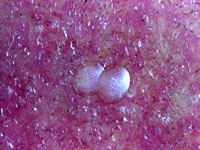
Figure 6. Eggs of the codling moth are laid on leaves or fruit. Photograph courtesy of Ken Gray Collection/Oregon State University. |
When full grown, larvae are 1/2 to 3/4 inches long. They emerge from the fruit and seek a protected site where they spin a cocoon. The cocoons are typically found beneath bark and underneath debris around the base of the tree. Larvae that are present in late spring and early summer pupate within the cocoon and subsequently produce a second generation; a third generation may also be produced in some locations. Larvae that emerge from fruit in mid-late summer do not pupate until the following spring, spending winter as a full-grown larva within the cocoon.
Management of Codling Moth
Successful management of codling moth is dependent upon many factors such as size and extent of the codling moth population, number, size and condition of trees, presence of natural enemies, available pesticides, and tree owner attitudes. There is no one-size-fits-all best management strategy for all homeowners wishing to manage codling moth.
Natural Controls
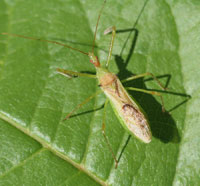
Figure 7. The assassin bug Zelus luridus is one of many insects that will feed on codling moth and other insects found in apple and pear trees. |
There are great many natural controls of codling moth, including some parasitic wasps and a host of generalist predators of insects (e.g., assassin bugs, minute pirate bugs, green lacewing larvae) (Figure 7). On unsprayed trees, or on trees where the insecticides used are selective in their effects (e.g., codling moth granulosis virus) these natural enemies can provide an important supplemental control of codling moth—and other insects/mites that may affect the crop (e.g., pear psylla, mites). However, due to the serious nature of codling moth injury, where a single larva can destroy a fruit, the natural enemies present for codling moth often will not provide control that is fully acceptable.
Trichogramma wasps, minute parasitic wasps that develop in the eggs of various moths, are available from several suppliers of biological control organisms. Potentially they may help suppress codling moth populations if applied repeatedly to coincide with periods when codling moth eggs are present, although effectiveness in home orchard settings has never been studied and should be considered experimental.
Cultural Controls
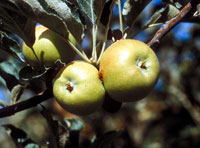
Figure 8. A common point where codling moth larvae will enter fruit is where two fruit are in contact. Thinning fruit to avoid fruit-to-fruit contact can help control the insect. |
Fruit Thinning and Removal. Successful entry of codling moth larvae is favored at sites on the fruit where there is some protection. A common point of entry is where two fruit are in contact (Figure 8). Thinning fruit to prevent this can result in reduced fruit attacks. Thinning of fruit also makes good spray coverage possible and spray programs are much more successful on properly pruned trees with thinned fruit crops.
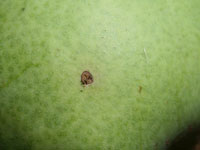
Figure 9. The original entry wounds made are quite small, but do indicate that a fruit is infested by a developing codling moth caterpillar. |
Fruit that is already infested and that still contain larvae should be picked and destroyed (Figure 9). These can be identified by checking for ‘stings’ and other evidence of entry points. Infested fruit should be removed from the site as larvae will continue to develop normally in fruit that is merely dropped to the ground.
Sanitation. Successful pupation of codling moth is dependent, in part, on there being adequate sources of cover. Removing sheltering debris from the vicinity of the base of the tree can deny cover. Flaps of bark that may develop on older trees also provide pupation sites and these should be eliminated. Fruit that contain developing larvae should be picked and destroyed.
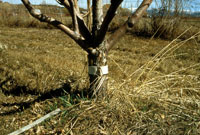
Figure 10a. Banding trunks of trees with cardboard or burlap bands can provide sites where codling moth will pupate. They can then be collected and destroyed. Photograph courtesy of Rick Zimmerman. |
Trunk Banding. Trunk banding involves purposefully providing areas for pupation, so that the insects can later be destroyed. Bands can be created by cutting strips of corrugated cardboard 1 1/2 to 2 inches wide and long enough to wrap around a branch. (Burlap, tied to the trunk, may also be used as a band.) Place the cardboard bands around branches at points where there is a transition from smooth to rough bark (Figures 10a and 10b). Place the corrugated face of band around branch and staple. As the codling moth larvae leave apples, they will crawl down the branch and move into the corrugated openings as a site for pupation. If there is loose bark on the fruit trees that can provide alternate places for pupation the bark flaps should be removed.
During the growing season bands should be checked frequently (every week or two), during periods that coincide with the end of a generation, the time when the full-grown larvae are moving to pupation sites. The larvae can be killed by crushing or removing and replacing bands. Larvae that are overwintering within the band can be removed any time after apples have been removed from the tree and before the emergence of adults the following spring.
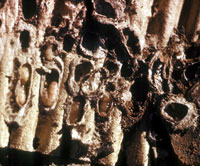
Figure 10b. Codling moth larvae preparing to pupate within a cardboard band placed on an apple tree trunk. |
Bagging. Individual fruit may be enclosed in a small paper bag to exclude codling moth. Most readily available are No. 2 paper bags commonly used for lunches. A slit cut in the bottom can allow the bag to be slipped over the fruit and the opening is then stapled closed. Fruit should be covered when they are about 1/2 to 1-inch diameter.
Varietal Differences. No apples or pears are completely resistant to codling moth. There are some small differences in susceptibility based on fruit firmness, with firmer fruited varieties being somewhat less susceptible. Early maturing varieties take less management time because they are harvested sooner while later maturing varieties are still on the tree and at risk of infestation from the third generation of codling moth.
Trapping Codling Moth
There are several traps that can be used in management of codling moth. Some of these are useful for detecting when moths are active so that critical periods (e.g., egg laying) can be determined. Such monitoring allows more effective and better targeted use of insecticides and is discussed below. Trapping that captures females may also provide some control.
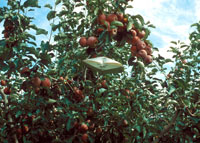
Figure 11a. A pheromone trap for codling moth, baited with the sex attractant produced by the female. Photograph courtesy of Rick Zimmerman. |
Pheromone Traps. The sex pheromone produced by females to attract male moths can be produced and used as a lure (Figures 11a and 11b). These will attract males only and have no effect on females. Traps that incorporate pheromone lures are routinely used to monitor flight activity of codling moth. However, alone they are not useful for control.
The addition of pear ester to a pheromone lure will increase captures of males and also capture females. This blend may help provide a minor amount of suppression of codling moth.
Homemade Lures. Many moths, including codling moth, can be attracted to fermenting sugar-based lures. A common lure involves molasses diluted about 1:7 in water. Natural yeast will ferment this mixture making it attractive to codling moths. Beer and diluted fruit juices are also sometimes used for making moth lures. For controlling codling moth these mixtures should be placed in an open container (e.g., a cut plastic milk jug, 2-liter bottle) and hung on or near fruit trees. Adding a few drops of soap or other material that breaks surface tension may increase moth captures.
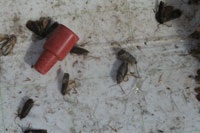
Figure 11b. Codling moth males trapped on the sticky surface of a pheromone trap. The red rubber septa contains the sex pheromone produced by the female. |
Bug Zappers. There are some commercial orchards which utilize bug zappers or light traps to reduce codling moth populations. This is a significant expense and not widely practiced. However, there may be some reduction in both female and male codling moth if a light trap/bug zapper is place in the upper 1/3 of the tree canopy. Keep in mind the light traps/bug zappers will also kill large numbers of beneficial insects.
Mating Disruption
Mating disruption is a technique where sex pheromones of an insect, used for detecting mates, are placed throughout an area to saturate the environment with the pheromone. If successful, males will be unable to locate females to mate and, in the absence of successful mating, only infertile eggs are laid.
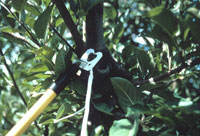
Figure 12. Twist-tie strips containing pheromone of codling moth being attached to branches for use in mating disruption within a commercial orchard. Large amounts of pheromone are emitted that can confuse male moths and disrupt mating. Photograph courtesy of Rick Zimmerman. |
Mating disruption for codling moth is widely used in apple and pear orchards and can be very successful under the correct circumstances. Pheromone emitting lures (e.g., IsoMate, No Mate, CheckMate) are placed on fruit trees so that an area becomes permeated with the pheromone that is produced by the female to attract mates (Figure 12). This potentially prevents much of the mating, although areas around the periphery of orchards or orchards adjacent to nearby sources of mated females may continue to be at risk of infestation by migrant moths.
Unfortunately, mating disruption is generally ineffective and not recommended for backyard growers and commercial growers who have less than 10 acres of apples or pears. This technique only works to prevent mating and has no effect on a female moth that has already successfully mated. In small plantings there are usually ample sites where mating can occur outside the pheromone-treated area, and the mated females then migrate to susceptible fruit trees.
However, if a backyard tree is somewhat isolated from other apple or pear trees, the owner may have some success at decreasing male and female moths by using pheromone traps which have lures containing pheromone blends which attract both males and females.
Monitoring Codling Moth
The emergence of codling moths in spring and their subsequent flight activity during the growing season can be easily monitored by use of pheromone traps. Various designs of traps are available but all have a sticky bottom and attract male moths by use of a lure that mimics the female sex pheromone. The lures typically last about 3-4 weeks and need to be periodically changed. Traps may also need to be changed, particularly when the sticky bottom gets covered with soil, debris, and moths.
Traps should be placed out prior to first bloom in order to detect the first emerging male moths. Once moths have been consistently captured, it can be expected that the first eggs will be laid in about a week. By regularly monitor traps one can also detect when the flight of the second generation of moths is occurring in early summer. This information can be useful in improving timing of sprays used to control codling moth.
Optimum spray timing can be more exactly estimated by combining pheromone trap captures and using information on local temperatures to determine degree days. In this system the date of the first trap capture is known as the Biofix point. The capture of at least 2 moths on two consecutive nights is often used to establish the Biofix.
Degree days are a measure of temperature occurring during a day. They are useful for predicting activity of codling moth (and many other insects) because insects are cold-blooded and development follows temperature.
Degree-days are determined by use of the average temperature for a day (maximum temperature + minimum temperature/2) and subtracting it from the base temperature at which the insect does not develop. For the codling moth a base temperature of 50°F is used. (Temperatures above 88°F are upper thresholds for codling moth activity and should not be included in degree day accounting.) As an example, a day when the high temperature was 80°F and the low temperature was 60°F, then 20 degree days would accumulate [(80 + 60/2) – 50]. Table 1 lists codling moth activities that can be predicted by use of this model.
(If a max/min thermometer is not available, a weather data base for many locations in Colorado is available at http://ccc.atmos.colostate.edu/~coagmet/. Once this website is accessed, go to monthly summaries. There will be a list of weather stations. Choose the weather station as close to your location as possible. Click on month and year and you will get a monthly summary of maximum and minimum temperatures.) Temperatures can vary between sites, so experience must play a data that is not generated on site.
Sprays to Control Codling Moth
There are only a very limited number of spray products on the home garden/consumer market that are available for managing codling moth in home orchards. All of these require repeated application, timed for periods when eggs are being laid and are hatching, and thorough coverage of fruit.
Carbaryl. Carbaryl is an older insecticide, typically sold under the trade name Sevin which can be highly effective against codling moth when applied during periods of egg hatch. It can provide control for a longer period than other treatments, typically 14-21 days. However, it is non-selective in its effects and can seriously damage natural enemies of other pests associated with the crops. It is also hazardous to honey bees and should never be applied to crops until after petal fall and trees are no longer attractive to pollinators. An interval of 3 days (preharvest interval) must pass from the period of last application and harvest.
Spinosad. Spinosad is a naturally derived material, produced by soil microbes (active ingredient, spinosyns). Several formulations are available, most of which are allowed to be used in Certified Organic production. Combination with horticultural oil is often useful in increasing control and fruit coverage. Applications should be made at 10-14 day intervals during periods when eggs are hatching. Effects of spinosad on natural enemies of fruit-infesting insects generally are minimal, although some are susceptible. There is a 7 day preharvest interval and a maximum of six applications can be made per season.
Acetamiprid. Acetamiprid is an insecticide recently made available for home orchard use (e.g., Ortho Flower, Fruit and Vegetable Insect Killer). It has systemic activity, which can be useful in improving coverage and can control some other insects found on the trees. However, it is not selective in effects and may kill natural enemies of codling moth; it also cannot be applied until after petal fall as it is hazardous to pollinators. Acetamiprid may be applied a maximum of 4 times a season, at intervals of at least 12 days between applications. There is a required 7 day preharvest interval following the last application and harvest.
Codling moth granulosis virus. A virus specific to codling moth is available by mail order from several garden/farm supply companies, sold under the trade name CYD-X. If ingested the virus produces a lethal disease that kills larvae within 3 to 7 days. Advantages of using CYD-X include its specificity of action to codling moth larvae, which spares natural enemies. It is also allowed in Certified Organic production. Its primary limitation is that it must be ingested, so thorough coverage of apples must be in place prior to larval tunneling. Weekly applications are recommended and combination with horticultural oil can improve coverage and control. Applications can be made up to day of harvest.
Kaolin clay. Kaolin clay (Surround) is applied to fruit as a barrier to codling moth egg laying and successful entry into fruits. It must thoroughly cover fruits during periods when eggs are being laid. Advantages are that it is selective in effects on most natural enemies and pollinators, has very low hazard to humans and is allowed to be used in production of Certified Organic produce. The clay does leave a visible residue that, although edible, detracts from appearance unless washed off.
| Table 1. Key events in codling moth life cycles estimated by use of Biofix1 and subsequently accumulated degree days2. These estimates are adapted from Utah Pests Fact Sheet EN-13-06 (Codling Moth). | |
| Event | Approximate Degree Days Required following Biofix |
| Biofix (1st sustained capture of moths in pheromone traps) | 0 |
| Egg hatch begins after Biofix has been established | 220-250 |
| Peak period of 1st generation egg hatch/critical control period | 340-600 |
| End of first generation egg hatch | ca 920 |
| First egg hatch, 2nd generation | 1000-1100 |
| Peak period of 2nd generation egg hatch/critical control period | 1320-1720 |
| End of 2nd generation egg hatch3 | 2100 |
1Biofix is determined by the use of pheromone traps baited with the codling moth phermone lure (codlemone). Traps should be placed in trees shortly before bloom. The presence of two male codling moths in a trap is used to establish the date of Biofix.
2Degree days are based on daily calculating the number of degrees of temperature (F) that the average temperature (maximum temperature + minimum temperature/2) exceeds the base temperature of codling moth activity (50°F). Predictions of codling moth activity are based on the accumulated degree days following Biofix.
3A partial third generation may occur late in the season with egg hatch beginning at about 2160 degree days.
*W. Cranshaw, Colorado State University Extension specialist and professor, bioagricultural sciences and pest management; R. Hammon, area Extension agent, Mesa County. 6/13
Colorado State University, U.S. Department of Agriculture, and Colorado counties cooperating. CSU Extension programs are available to all without discrimination. No endorsement of products mentioned is intended nor is criticism implied of products not mentioned.
Go to top of this page.





